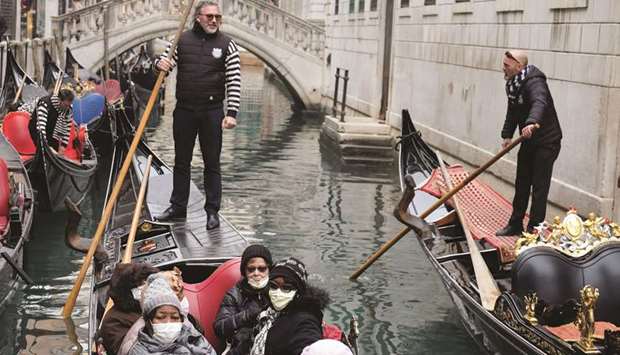Italian authorities, grappling with Europe’s worst outbreak of the novel coronavirus, were taking drastic action yesterday to contain the spread of the potentially deadly disease.
Since two clusters were identified this week in the northern regions of Lombardy and Veneto, the COVID-19 disease caused by the virus has killed two people.
A further 130 are infected with the virus, with numbers changing by the minute.
“We have to adopt drastic measures,” Veneto’s regional President Luca Zaia told reporters, indicating that he would cancel all public events, including Venice’s famous carnival.
As he spoke, festivities were already in full swing, with people revelling on St Mark’s Square.
Zaia indicated that the ban would be enforced at the end of the day’s carnival programme, originally due to last until tomorrow.
The Veneto president also closed all museums and schools, markets and fairs in a region that counts 5mn inhabitants and is one of Italy’s industrial powerhouses.
“It’s the last thing the president of a region would like to sign, but there are no alternatives,” Zaia said, predicting that other regions would follow suit.
In a sign of a spreading contagion, the first COVID-19 cases were reported in central Venice.
Two people aged almost 90 were under intensive care in the lagoon city’s hospital.
Similar anti-contagion measures were taken in Lombardy, home to 10mn people and comprising Milan, Italy’s second-largest city and its business and fashion capital.
Milan’s La Scala, one of the most famous opera houses in the world, suspended performances, and a Giorgio Armani event for the city’s fashion week was held in an empty theatre and shown livestreamed.
Universities were closed in both Lombardy and Veneto, as well as in other parts of northern Italy, including the city of Genoa and the regions of Piedmont and Emilia-Romagna.
The head of the Civil Protection Agency, Angelo Borrelli, gave the total number of infected as 132, including the two dead and three older cases in Rome.
Beyond 89 cases in Lombardy and 25 in Veneto, Borrelli listed six infections in Piedmont and nine in Emilia-Romagna, regions that respectively border Lombardy to the west and south.
In Rome, one of three COVID-19 patients has fully recovered and was dismissed on Saturday.
A couple of Chinese tourists remained hospitalised.
Deputy Health Minister Pierpaolo Sileri told the SkyTG24 news channel that outbreak numbers were likely to rise further.
“I expect more cases,” he said. “It’s clear that we will have more.”
Authorities were still searching for so-called “patient zero” examples, meaning the persons who brought the China-originated virus to northern Italy.
In Lombardy, the first case was detected on a hospital patient, an Italian man, with no obvious connection to China.
From there, the virus spread to medical staff and other patients.
In response to the crisis, the government decided overnight to block access to around a dozen towns at the centre of the outbreak, forcibly confining tens of thousands of people.
The measure concerns 10 towns in Lombardy’s Lodi province, about 60km southeast of Milan, where around 50,000 people live, and Vo’, a town of around 3,000 in Veneto’s Padua province.
“It’s like a war-time situation,” a man from Casalpusterlengo, one of the affected Lombardy towns, was quoted as saying by the Ansa news agency.
“Shops are closed, only supermarkets are open for a few hours, they let us in in batches, but they have run out of meat and they don’t know when they will get more,” he said.
The government also called off all sports events yesterday in Lombardy and Veneto, including three Serie A football games: Inter Milan v Sampdoria, Atalanta Bergamo v Sassuolo and Verona v Cagliari.
According to the World Health Organisation (WHO), no country in Europe has more COVID-19 cases than Italy.
Germany has 16, France 12, with one dead, and Britain three.
Overnight, Prime Minister Giuseppe Conte ruled out reintroducing border controls with European neighbours, in suspension of the EU’s Schengen rules.
But in Switzerland, the canton of Ticino said its hospitals would isolate and test all patients with COVID-19-type symptoms, even if they have no known links with China or with other infected patients.
Ticino is a neighbour of Italy’s virus-affected Lombardy region.
Some 68,000 people commute from Italy to Ticino for work every day.
In Austria’s Carinthia province, Governor Peter Kaiser has advised the region’s population to avoid travelling to Italy’s virus-affected regions for the time being.

Tourists wearing surgical masks wait for a gondola ride to start in Venice.
